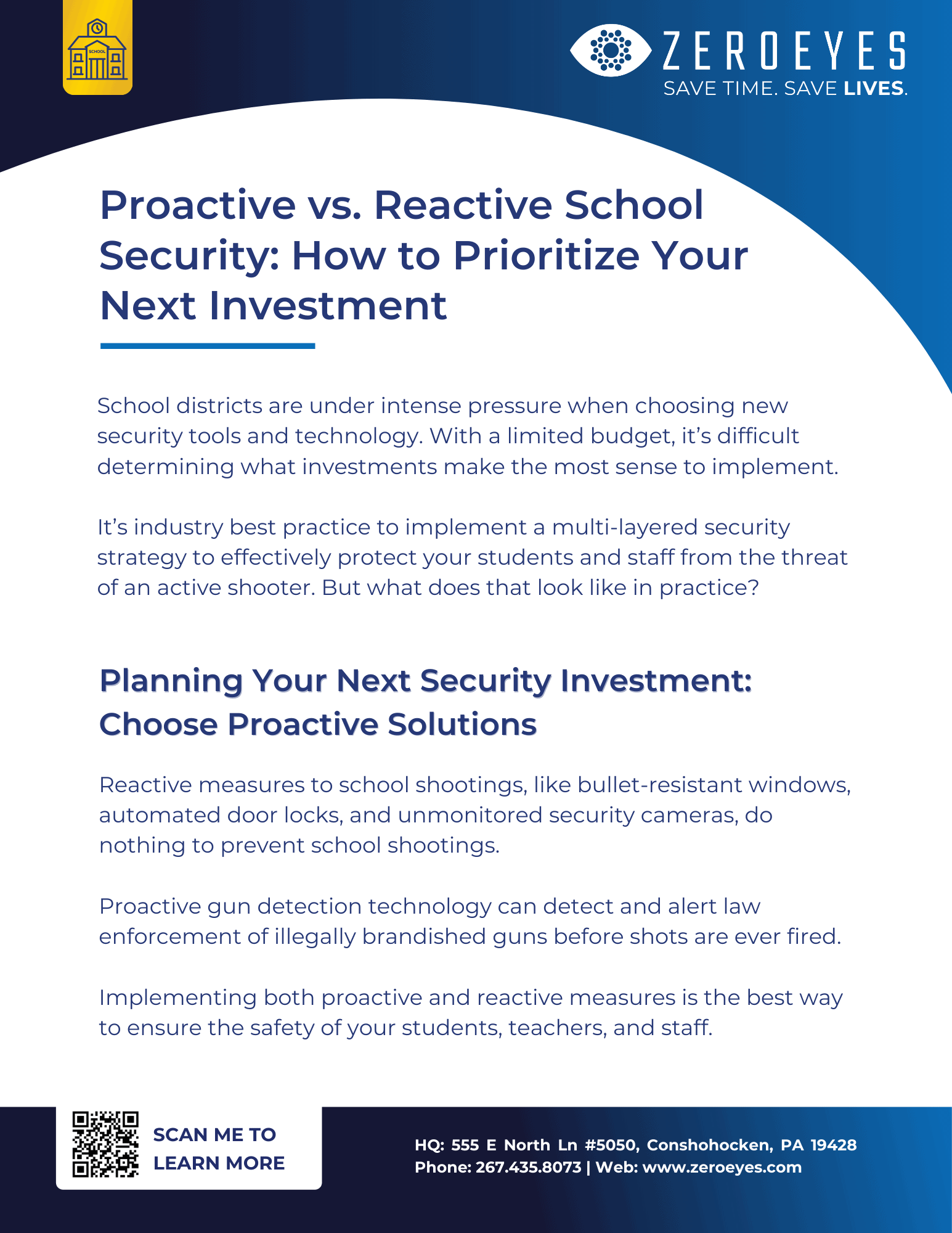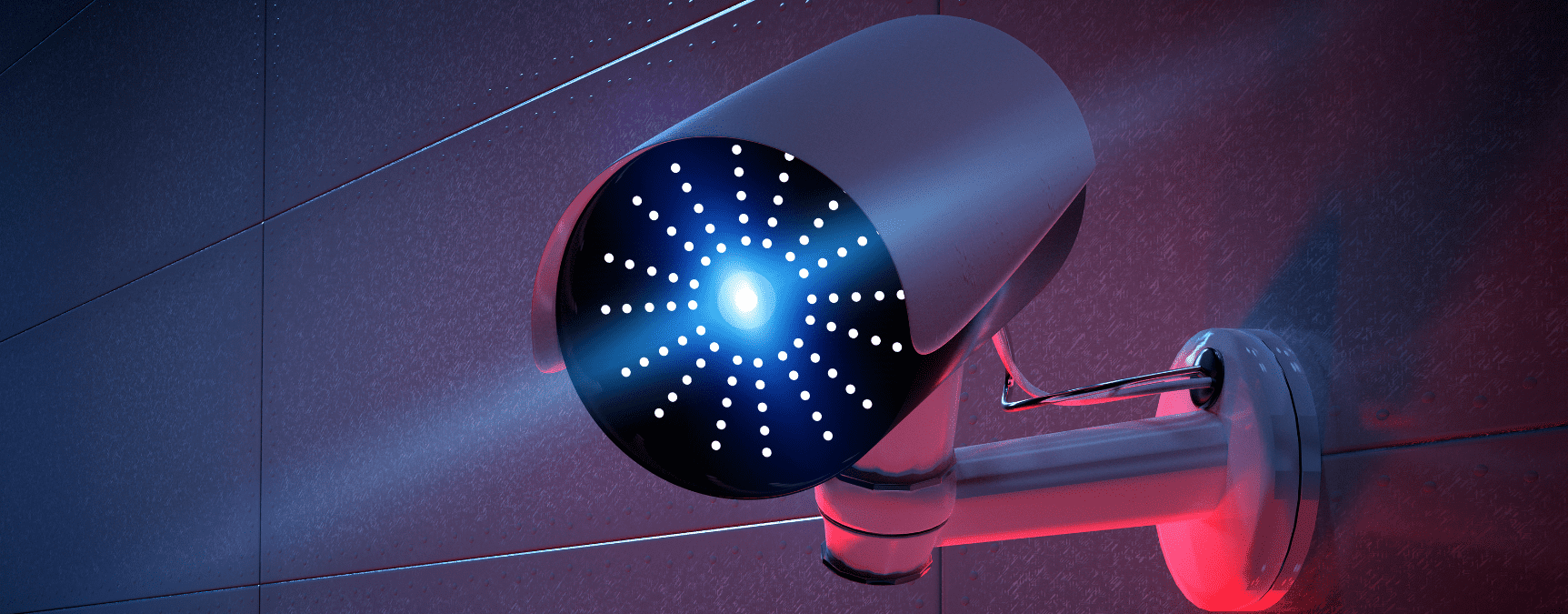Visit any K12 school or university in the U.S., and you’ll likely find school security cameras on campus. Security cameras are a good investment for school security systems, but those cameras alone don’t provide the protection our children need.
The reality is, most school security cameras aren’t actively monitored by security personnel for major threats, such as illegally brandished guns. Most often, they are used as a forensics tool after an incident occurs. But, with the right technology, digital school security cameras can detect guns as soon as they become visible. Early detection can drastically improve response and save lives.
This technology is available and used by schools nationwide today, and it’s called proactive gun detection.
What Is Proactive Visual Gun Detection Technology?
ZeroEyes CEO Mike Lahiff spoke with Jim Murtha of Pennsylvania Business Report about how proactive visual gun detection technology installed on already existing digital security cameras can be used to take action against the mass shooting epidemic our nation is experiencing.
You can listen to the full podcast here, but for major highlights of how a proactive visual gun detection system can help create safer schools and how it works, read on.
The Problem With School Security Cameras Today
Mike Lahiff: It was shortly after the Parkland School shooting. My daughter came home—my oldest daughter was in middle school at the time—she came home pretty upset because our school started doing active shooter lockdown drills. And I was like, this is absurd.
I was sitting in her school shortly after that, waiting to pick her up from practice. I was looking around, and there were cameras everywhere. I asked the security guard, “Who’s looking at the cameras?” And he chuckled and said, “No one’s looking at them. We just go back and look at them after something has happened.”
And I thought, that’s interesting…
I knew some folks doing facial recognition technology, but there were a lot of headwinds with privacy concerns. I thought, why don’t we use the digital security cameras to detect guns?
So, when you detect a gun, send an alert to local staff, security, and first responders. Now they can identify the person, what type of weapon they have, and locate them on a map. So, we can ideally stop a shooting from happening before shots are fired, decrease response times, and get people to safety as soon as possible.
Jim Murtha: How about your experience as a SEAL? Did that factor into your thinking here?
Mike Lahiff: Yes, absolutely. I would have loved to have technology like this when I was in the SEAL teams. Unfortunately, I did not. The idea of having alerts sent to you when you’re going into a building or into a certain location—so you know where that exact person is moving, where that threat is—can really decrease those response times.
That actionable intel’s imperative to save lives. I would have loved to have it when I was in the SEAL teams, and I didn’t even know that it was technically feasible until I got out of the military and I met some folks working in the tech space.
How Visual Gun Detection Can Turn School Security Cameras Into a Proactive Solution
Jim Murtha: Explain exactly how it works. You got a system installed, and let’s say there’s a threat…what’s the machinery here? What’s the back office like? What are you going to do on the front end with technology in order to make this work?
Mike Lahiff: Yeah, I’ll give you a 30,000-foot view of it, because we could fall down some serious rabbit holes on the tech side. You have digital security cameras—picture a school, a place of business, or wherever that has a lot of digital security cameras. All those digital security cameras are wired back to somewhere, some server on some network. We go and put software on it.
So those security feeds now run through our software. And we have a computer vision model artificial intelligence sitting in there, that’s scanning all those frames coming in from those video feeds, looking for a gun.
When it thinks a gun is detected, it sends an alert, and it goes up into our operations center, where we put a human in a loop to say, “Yes, that is a gun,” or “No, that is not a gun.”
Jim Murtha: So, the system is scanning constantly?
Mike Lahiff: Right. Never sleeps. It’s 24/7/365, doesn’t get tired, it’s not looking at its Facebook, it’s not getting distracted. It has one purpose.
Jim Murtha: Let’s say, for example, you have a system installed in a school, and some kid comes in with a weapon, and your software identifies it. What happens then?
Mike Lahiff: That alert will come to our operations center. One of our operations folks would say, “Yes, that is a real gun,” and they hit dispatch. That alert goes back to our clients through a desktop and mobile app notification to whoever they deemed they wanted on that list to receive that alert.
But simultaneously, it goes to the local PSAP 911 center, because that 911 operator will be given intel to provide any communications to first responders. Such as “5’10” white male, appears to be an assault rifle, Northeast corner, the main building’s first floor.”
So now, when they’re responding, they know exactly where to go and who to look for. Where in an environment, like what you see in Parkland or something, they’re showing up to a 100-acre campus. They might end up thinking that from the frantic 911 calls—it’s very chaotic, there’s a lot of fog—they might think they have to go to the high school stadium when the shooter is on a second floor shooting out of the window at the high school stadium.
So we’re really trying to minimize the confusion and provide that actionable intel to first responders.

Proactive vs. Reactive School Security
An effective multi-layered security plan includes both proactive and reactive layers—but most school security systems include only reactive measures. Learn what the differences are here and what a strong multi-layered plan should look like.
Examples of When Early Detection On School Security Cameras Could Have Changed Tragic Outcomes
Jim Murtha: Given the number of mass shootings we’ve had in this country in the last 20 years, can you give me an example of a mass shooting that has occurred that, if the ZeroEyes system was in place, it might have prevented it?
Mike Lahiff: Yeah, so that’s always a difficult spot for us because, you know, it’s tough to go back and kind of “armchair quarterback” something, but to give some examples…
The Parkland School shooting. That individual entered at the stairwell, and the gun was hidden in the bag, concealed. He stood in the stairwell for some time under a video camera feed, pulled the gun out, was messing with his gun, another student walked by, and then he stepped out into the hallway and pulled the fire alarm. And then started engaging with students.
Another example, Sandy Hook. Didn’t see that on the camera feed—I imagine they don’t want to release that. But that individual pulled up and parked in a fire lane, got out of his car, pulled the weapon out of the car, walked up to the front doors… completely exposed weapon. Tries to open the doors, but they’re locked. He steps back, shoots through the doors, and then works his way through to school.
Uvalde. They had him on video camera approaching the school after he crashed his truck.
Jim Murtha: Yeah, I remember that. He was in the back of the building, and the door was left open.
Mike Lahiff: Yeah. And so you see it in these big, active shooter events where there are multiple casualties time and time again. You have to think, these individuals aren’t trying to be super creative. They’re basically on a suicide mission. Obviously, they’re not thinking clearly. They do not care if people see them with the weapon. They want people to see that they’re like, “Look at me, I’m the big scary monster.” And that’s what we’re really trying to stop.
Are Schools Adding Visual Gun Detection Technology to Their Security Cameras?
Jim Murtha: Are schools sufficiently aware of the severity of the problem? Are you getting a willing audience for your sales pitch among a lot of these school districts?
Mike Lahiff: So, schools are very aware of the problem. It’s probably the top three in almost every school district across the United States: school security.
Which is a shame. They should be focused on education, not school security. But it’s, unfortunately, the world we live in today. So they’re very receptive because they’re looking for solutions. They’re like, “what do we do?”
And you don’t want to turn schools into prison systems. So we have a noninvasive system. You know, it’s not like you want kids walking through something like airport security every morning going to school. That’s terrible.
And then we’re a proactive solution. It’s something that can help before shots are fired. It’s been very receptive. That’s why we’re in over 30 states now. And the adoption is picking up very quickly.
See what other school districts across the nation have to say about their experience implementing ZeroEyes’ proactive gun detection on school security cameras. If you’re interested in what you see, reach out to us for a live demo.


